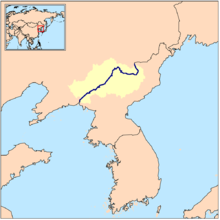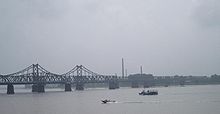- Yalu River
-
Yalu River 
Chinese name Traditional Chinese 鴨綠江 Simplified Chinese 鸭绿江 Transcriptions Mandarin - Hanyu Pinyin Yālù Jiāng - Wade–Giles Ya-lu Chiang - IPA [jálŷ tɕjɑ́ŋ] Cantonese (Yue) - Jyutping aap3 luk6 gong1 - IPA [áplʊ̀kgɔ̄ːŋ] Korean name Chosŏn'gŭl 압록강 Hancha 鴨綠江 Transcriptions - McCune-
ReischauerAmnokkang - Revised
RomanizationAmnokgang Manchu name Manchu Yalu ula
(Möllendorf)The Yalu River (Manchu and Chinese) or the Amnok River (Korean) is a river on the border between North Korea and the People's Republic of China.
Together with the Tumen River to its east, and a small portion on Changbai Mountain, the Yalu River forms the border between North Korea and the People's Republic of China.
The Chinese name translates literally as Duck Green River, but is actually a phonetic rendering of a Manchu word meaning "the boundary between two countries"[citation needed]. The Korean name is the Korean pronunciation of Hanja characters.
Contents
Geography
From 2,500 m above sea level on Changbai Mountain, on the China-North Korea border, the river flows south to Hyesan before sweeping 130 km northwest to Linjiang and then returning to a more southerly route for a further 300 km to empty into the Korea Bay between Dandong (China) and Sinŭiju (North Korea).
The bordering Chinese provinces are Jilin and Liaoning.
The river is 790 km (491 mi) long and receives the water from over 30,000 km² of land. The Yalu's most significant tributaries are the Changjin (장진강, 長津江), Heochun (허천강, 虚川江) and Tokro rivers. The river is not easily navigable for most of its length: although at its widest it is around 5 km, the depth is no greater than 3 m and much of the river is heavily silted.
History
The river basin is the site where the ancient kingdom of Goguryeo rose to power. Many former fortresses are located along the river and the former capital of that kingdom was situated at what is now the medium-sized city of Ji'an, China along the Yalu, a site rich in Goguryeo era relics.
The river has been the site of several battles because of its strategic location between Korea and China, including:
- Battle of the Yalu River (1894) – Sino-Japanese War (1894-1895)
- Battle of Yalu River (1904) – Russo-Japanese War
The Korean side of the river was heavily industrialized during Colonial Korea (1910–1945), and by 1945 almost 20% of Imperial Japan's total industrial output originated in Korea. During the Korean War the movement of UN troops approaching the river precipitated massive Chinese intervention from around Dandong. In the course of the conflict every bridge across the river except one was destroyed. The one remaining bridge was the Sino-Korea Friendship Bridge connecting Sinuiju, North Korea to Dandong, China. During the war the valley surrounding the western end of the river also became the focal point of a series of dogfights for air superiority over North Korea, earning the nickname "MiG Alley" in reference to the MiG-15 fighters flown by the combined North Korean, Chinese and Soviet forces. U.S. General Mark W. Clark initiated Operation Moolah to influence a Communist MiG-15 pilot to defect with the MiG to South Korea in 1953 and receive a financial award and political asylum. LT No Kum-Sok would defect after the signing of the armistice in September 1953.
The river has frequently been crossed by North Koreans fleeing to China Since the early 1990s.
Economy
The river is important for hydroelectric power, and one of the largest hydroelectric dams in Asia is in Sup'ung Rodongjagu, 100 m high and over 850 m long, located upstream from Sinuiju, North Korea. The dam has created an artificial lake over a portion of the river, called Sapung Lake. In addition the river is used for transportation, particularly of lumber from its forested banks. The river provides fish for the local population.
Crossings
- Sino-Korean Friendship Bridge, Dandong, China - Sinŭiju, North Korea
- Ji'an Yalu River Border Railway Bridge, Ji'an China - Manp'o, North Korea
See also
- Geography of China
- Geography of North Korea
- List of China-related topics
- List of Korea-related topics
- List of rivers of Asia
- Chinese–Korean border fence
External links
Jilin topics General Geography Education Culture Visitor attractions Gungnae Fortress • Tomb of the General • Baekdu Mountain • Heaven Lake • Ancient Tombs at Longtou Mountain • Mausoleum of Princess ZhenxiaoCategories:- Rivers of Jilin
- Rivers of North Korea
- International rivers of Asia
- China–North Korea border
Wikimedia Foundation. 2010.

